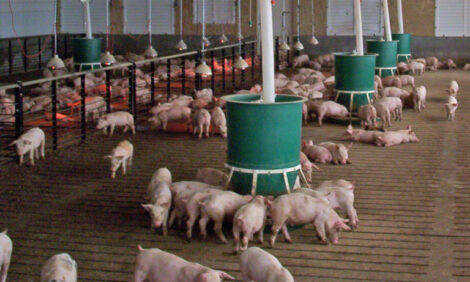



US Pork Outlook - April 2011
Recent larger pig numbers are expected to be mainly offset by continued strong domestic and international demand for US pork, according to the latest Livestock, Dairy, and Poultry Outlook from the USDA's Economic Research Service.Summary
Pork/Hogs: The March Hogs and Pigs report showed a slightly larger inventory of market hogs, but any price effects of the slightly larger numbers are expected to be largely offset by continued strong domestic and international demand for US pork. Continued productivity gains are likely to reduce effects of hog producers’ stated intentions to reduce spring and summer farrowings.
2011 live equivalent prices of 51 to 52 per cent lean hogs are expected to be $62 to $65 per cwt, compared with $55.06 a year ago. Second-quarter 2011 prices are expected to be $67 to $69 per cwt, up from $59.60 in the same period of 2010. February exports were more than seven per cent greater than in February 2010, with Japan, Mexico and South Korea together accounting for 64 per cent of shipments.
Pork/Hogs
All hogs and pigs inventory increases while farrowing intentions lag
The Quarterly Hogs and Pigs report released by USDA on 25 March offered a mixed perspective of US hog production. The report showed a slightly higher 1 March inventory of all hogs and pigs. The market hog component of the inventory was almost one per cent larger than a year ago. With all other factors unchanged, slightly higher market hog numbers could be expected to have a dampening effect on hog prices. But it is more likely that expected strong domestic and foreign pork demand will offset any downside price effects of higher market hog inventories.
The report also indicated that producers intend to farrow about three per cent fewer female breeding animals in both the spring (March-May) and summer (June-August) quarters of this year. Even if producers follow through with their stated intentions, it is likely that continued gains in pigs per litter will limit production effects of lower farrowings. Productivity gains are thus expected to combine with lower stated intentions to yield a spring pig crop only slightly smaller than a year ago. Lower summer farrowings are expected to be more than offset by continued gains in seasonally high litter rates, and thus to result in a marginally higher summer pig crop.
Commercial hog production this year is expected to be 22.6 billion pounds, slightly higher than last year. Second-quarter production is expected to come in at 5.35 billion pounds, almost one per cent above the same period last year. Live equivalent prices of 51 to 52 per cent lean hogs are expected to be $62 to $65 per cwt this year, more than 15 per cent above 2010 prices. For the second quarter, the expected price of $67-$69 is more than 14 per cent above the same period last year.
February exports strong
February US pork exports were almost 388 million pounds, more than seven per cent higher than a year ago. While the relatively low-valued US dollar benefited most buyers of US pork products in February, the value of the dollar with respect to the Japanese yen, in particular, likely spurred Japanese purchases of US pork. February exports also reflect expected higher shipments to South Korea, in the aftermath of a series of recent outbreaks of foot and mouth disease. Shipments to Japan, Mexico and South Korea accounted for about 64 per cent of exports in February. First-quarter pork exports are expected to be 1.15 billion pounds, almost 10 per cent above the same period a year ago. For the year, US pork exports, forecast at 4.675 billion pounds are expected to be 10.6 per cent higher than a year ago and to account for 20.7 per cent of US commercial pork production.
US pork imports, at 60.4 million pounds in February, were about 7.2 per cent lower than a year ago. Of the five largest sources of imported pork, February shipments from Canada, Denmark and Italy were lower, while imports from Poland and Mexico were higher, year-over-year. While the relatively low value of the US dollar typically spurs US pork exports, it is also likely that US pork imports in February were slowed by the effects of the low-valued dollar. Live swine imports were almost 461,000 head in February, 1.7 per cent lower than in February 2010. Live swine imports were almost 461,000 head in February, 1.7 per cent lower than in February 2010. US imports of segregated-early-weaned animals increased almost nine per cent, likely reflecting strong returns in February from finishing hogs in the United States.
Further Reading
| - | You can view the full report by clicking here. |
April 2011








